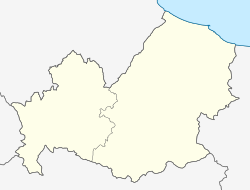This article includes a list of general references, but it lacks sufficient corresponding inline citations .(August 2025) |
Larino | |||||
|---|---|---|---|---|---|
 | |||||
| General information | |||||
| Location | Via Romano [1] Larino, Campobasso, Molise Italy | ||||
| Coordinates | 41°48′00.72″N14°55′05.16″E / 41.8002000°N 14.9181000°E | ||||
| Operated by | Rete Ferroviaria Italiana | ||||
| Line(s) | Termoli-Campobasso Termoli–Venafro | ||||
| Platforms | 2 | ||||
| Tracks | 3 | ||||
| Train operators | Trenitalia | ||||
| Other information | |||||
| Classification | Bronze | ||||
| History | |||||
| Opened | 1882 | ||||
| Electrified | no | ||||
| |||||
Previous-Next station | ||||||||||||||||||||||||||||||||||||||||||||||||||||||||
|---|---|---|---|---|---|---|---|---|---|---|---|---|---|---|---|---|---|---|---|---|---|---|---|---|---|---|---|---|---|---|---|---|---|---|---|---|---|---|---|---|---|---|---|---|---|---|---|---|---|---|---|---|---|---|---|---|
| ||||||||||||||||||||||||||||||||||||||||||||||||||||||||
Larino railway station is the railway station that serves the municipality of Larino. Is situated in the centre of the city.

